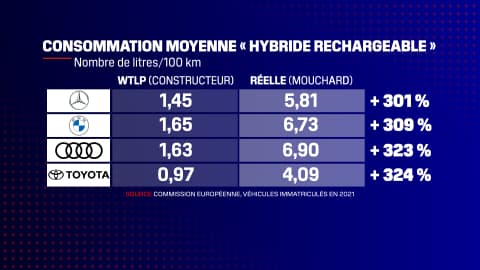We might have suspected it, but the numbers are edifying. According to a report by the European Commission, plug-in hybrid cars consume between three and four times more than what manufacturers advertise to their buyers. To establish this observation, the authors of this comparative study relied on data transmitted by cookies installed in vehicles since 2021.
No one will be surprised to discover that the consumption established according to the world WTLP standards and provided by the manufacturer based on laboratory tests, differs somewhat from reality for thermal cars. However, this difference is limited to 1 liter per 100 kilometers for vehicles equipped with a diesel engine (6.88 versus 5.82).
From 1.7 liters announced to 6 liters per 100 kilometers observed
The difference increases a little for the gasoline models: 1.5 liters more, or a 24% difference. But this is not proportional to the difference between the advertised and actual consumption of rechargeable hydrides. The average, all manufacturers together, in WTLP standard, is less than 1.7 liters while according to the data collected by whistleblowers, it is around 6 liters per 100 kilometers.
That is, motorists who drive a plug-in hybrid car consume on average 3.5 times more fuel than the level indicated by dealers when purchasing it. And again, this is an average. For those who opted for the large SUVs sold by Mercedes, BMW, Audi or Toyota, it will be four times more, or even more.

We understand that this difference is greater, since these brands have prioritized the change to plug-in hybrids in their SUVs and large sedans, which already weigh a lot and in which a battery has been integrated that can weigh several hundred kilos.
Differences linked to driving style, types of journeys and charging frequencies
These enormous differences may suggest that manufacturers are cheating. The reality is more complex. Because if in “real life” hybrid cars consume between three and four times more than what their manufacturers announce, it is for three main reasons. First of all, the driving style of its users. They tend to ignore the recommendations of specialists who recommend soft starts and maintaining, as far as possible, a stable speed.
Then, the actual use of your car, with a proportion of long-distance trips (in thermal mode) greater than that provided by the standard for calculating consumption in the laboratory. Finally, the burden of periodically recharging a battery that allows you to travel less than one hundred kilometers in electric mode. Plug-in hybrids do not plug into the necessary sockets as often as necessary.
The mileage traveled in electric mode is, therefore, much lower than what the car theoretically allows. However, this consumption data may change over time. Many of the first plug-in hybrid models were purchased by companies for tax reasons. And their users are likely to be less sensitive to the optimal use conditions of these cars.
A triple advantage for car manufacturers
However, we cannot exonerate manufacturers from all responsibility. They are also the winners of the deal. Because with this emphasis on minimal consumption, they more easily attract buyers for whom the issue of sobriety is not secondary. There is also the issue of the enormous penalty that weighs on thermal SUVs. Although in this area the rules will change in France next year, since plug-in hybrid models will be affected by the weight penalty.
Finally, the most important point, the average reduction in CO2 emissions per car sold to which manufacturers are obliged. The calculation is based on WTLP consumption. And the stakes are colossal: the fines that must be paid to the EU in case of non-compliance amount to hundreds of millions of euros and can quickly exceed one billion.
Source: BFM TV

